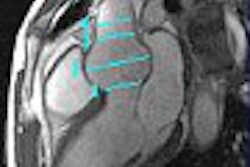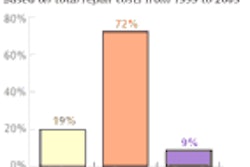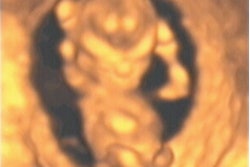(Ultrasound Review) Researchers at Vanderbilt University Medical Center recently evaluated tumor growth and proliferation using contrast-enhanced sonography to measure vascularity in implanted tumors.
Findings were compared with the standards of magnetic resonance imaging (MRI) and FDG autoradiography, which estimated the percentage of viable tumor. Angiogenesis or neovascularisation refers to the development of and maintenance of vascular networks, and this process is essential for tumor growth and proliferation.
The group implanted Madison lung tumors into 10 mice. Contrast-enhanced sonography, MRI, and FDG autoradiography were used to establish tumor vascularity and percentage of viable tumor.
A microbubble contrast agent (Definity, Bristol-Myers Squibb Medical Imaging, North Billerica, MA) was infused via the jugular vein and a high-resolution linear array (15-7 MHz) was used in conjunction with harmonic imaging and a low output power (mechanical index 0.1).
They found "quantitated estimates of tumor vascularity with contrast-enhanced sonography closely correlated with estimates made by MRI and with the percentage of viable tumor (r = 0.93) as depicted by FDG autoradiography."
According to the authors "recently, novel therapeutic agents have been developed, which affect tumor growth and spread on the basis of their ability to target tumor angiogenesis." They sought to develop a diagnostic tool that assessed tumor response by demonstrating changes in tumor vascularity and function.
"Vascularity was quantitated by a specifically designed program for weighted pixel quantification (HDI-Lab)," they reported. A 4.7-tesla scanner was used to obtain MRI images before and after gadolinium injection.
Following a 300-µCi injection of 18-FDG, autoradiography was performed. The tumor was excised from the mice 45 minutes after injection and sectioned into 30-µm slices. The slices were radiographed using Kodak Min-R mammography film and the image digitized.
"The percentage of the tumor that had function was quantitated, as well as the relative amount of function as shown by the intensity (darkness) of the signal. This differs from the power-weighted pixel quantification used for contrast-enhanced sonography and MRI because FDG is also metabolized by viable tumor cells," the authors explained.
Although contrast-enhanced sonography demonstrates tumor necrosis, the assessment of subtle changes in tumor metabolism related to response hasn’t been thoroughly researched.
The authors also questioned whether contrast or treatment alters the tumor vessel permeability. They concluded, "contrast-enhanced sonography seems to be an accurate modality for serial assessment of tumor vascularity as an indication of tumor response." Contrast-enhanced sonography was an excellent tool for measuring tumor vascularity, which correlated with the amount of metabolically active tumor, they said.
Quantification of tumor vascularity with contrast-enhanced sonography: correlation with magnetic resonance imaging and fluorodeoxyglucose autoradiography in an implanted tumorFleischer, A. C., et. al.
Department of radiology, Vanderbilt University Medical Center, Nashville, TN
J Ultrasound Med 2004 January; 23:37-41
By Ultrasound Review
March 24, 2004
Copyright © 2004 AuntMinnie.com



















